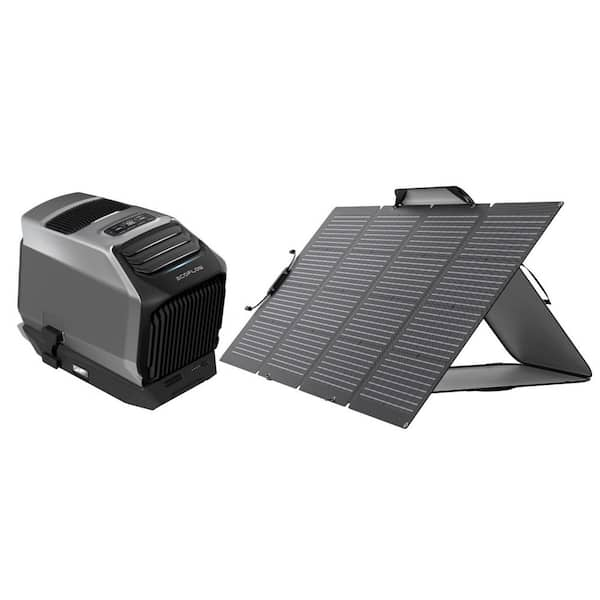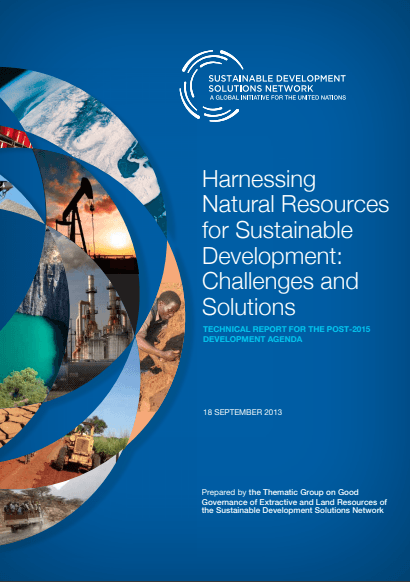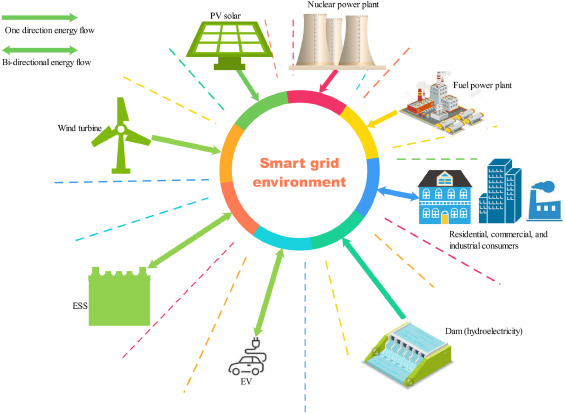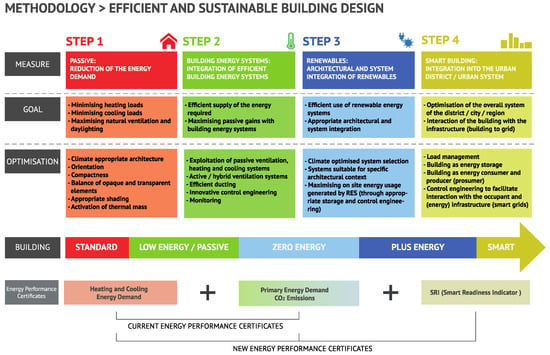Table of Contents
As the world grapples with the challenges of climate change and the increasing demand for cooling in hot summer months, the integration of renewable energy sources with air conditioning systems has emerged as a sustainable solution. Harnessing natural resources such as solar and geothermal energy to power air conditioners not only reduces carbon emissions but also provides long-term cost savings. In this article, we will explore the synergy between renewable energy and air conditioning, highlighting the benefits and innovative technologies driving this eco-friendly revolution.
In an era defined by the pressing challenges of climate change and the rising need for cooling solutions during sweltering summers, the fusion of renewable energy sources with air conditioning systems has emerged as a beacon of sustainability and innovation. This integration is reshaping the way we approach both environmental responsibility and comfort in our homes and businesses. Let’s delve further into the profound synergy between renewable energy and air conditioning, unraveling the multitude of benefits and groundbreaking technologies that are propelling this eco-friendly revolution forward:
Reduced Carbon Footprint: By harnessing renewable energy sources like solar and geothermal power to drive air conditioning systems, we significantly reduce carbon emissions. Traditional AC systems often rely on fossil fuels or grid electricity, which contribute to greenhouse gas emissions. In contrast, renewable energy sources are clean and sustainable, helping combat climate change.
Long-Term Cost Savings: One of the most compelling advantages of renewable energy-powered air conditioning is the potential for long-term cost savings. While the initial investment in solar panels, geothermal heat pumps or other renewable technologies may be substantial, the ongoing energy savings and reduced reliance on conventional energy sources can result in significant financial benefits over time.
Energy Independence: Integrating renewable energy sources provides a degree of energy independence. When your cooling system is powered by solar panels or geothermal heat pumps, you’re less vulnerable to fluctuations in energy prices or power outages. This energy resilience ensures uninterrupted comfort, even in extreme weather conditions.
Improved Air Quality: Renewable energy-powered air conditioning systems often feature advanced air filtration and purification technologies. These systems can remove allergens, pollutants and particulate matter from indoor air, enhancing the quality of the air you breathe. This is particularly beneficial for those with allergies or respiratory issues.
Incentives and Rebates: Many regions offer incentives, tax credits or rebates to encourage the adoption of renewable energy technologies. These financial incentives can make the initial investment more affordable and accelerate the transition to sustainable cooling solutions.
Technological Advancements: Renewable energy and air conditioning technologies continue to advance. Solar panels are becoming more efficient and cost-effective, while geothermal heat pumps are being optimized for better performance. These innovations make renewable energy-powered cooling systems more accessible and attractive to homeowners and businesses alike.
Grid Support: In some cases, renewable energy systems can provide excess energy that can be fed back into the grid, earning you credits or financial compensation. This not only offsets your energy costs but also supports the stability and sustainability of the broader energy infrastructure.
Increased Property Value: Homes and businesses equipped with renewable energy-powered cooling systems often command higher property values. Eco-conscious buyers and renters appreciate the sustainability and energy efficiency of such properties, making them more appealing in the real estate market.
Environmental Responsibility: By embracing renewable energy for air conditioning, individuals and businesses demonstrate a commitment to environmental responsibility. This aligns with global efforts to reduce carbon emissions and transition toward a more sustainable energy future.
In conclusion, the integration of renewable energy sources with air conditioning systems represents a transformative shift in how we approach comfort and sustainability. It addresses the challenges of climate change, reduces carbon emissions and offers substantial long-term cost savings. As technology continues to advance and renewable energy becomes more accessible, the synergy between renewable energy and air conditioning stands as a beacon of hope for a greener, more comfortable and environmentally responsible future.
For a comprehensive look at this subject, we invite you to read more on this dedicated page: Geothermal Heating and Cooling Technologies | US EPA
Solar-Powered Air Conditioning
Solar energy is one of the most abundant and accessible renewable resources available. Solar-powered air conditioning systems use photovoltaic (PV) panels to convert sunlight into electricity, which then powers the AC unit. Here’s why solar AC is gaining popularity:
Solar energy is undeniably one of the most abundant and accessible renewable resources available to us. Its immense potential for harnessing clean and sustainable power has led to significant advancements in various applications. One such innovation that has been gaining substantial popularity is the integration of solar power into air conditioning systems. Solar-powered air conditioning, which utilizes photovoltaic (PV) panels to convert sunlight into electricity to run the AC unit, is becoming increasingly attractive for several compelling reasons:
Energy Independence: Solar AC systems offer a degree of energy independence. By generating electricity on-site from sunlight, homeowners and businesses can reduce their reliance on the grid and, in some cases, even become completely self-sufficient in terms of cooling needs. This energy autonomy not only reduces utility bills but also provides a buffer against power outages, ensuring uninterrupted comfort.
Environmental Sustainability: Solar AC systems are a green and sustainable choice. They produce zero greenhouse gas emissions and help mitigate the carbon footprint associated with traditional air conditioning systems. Using clean energy from the sun aligns with global efforts to combat climate change and reduce environmental impact.
Cost Savings: While the initial investment in solar panels and the AC system may seem substantial, the long-term savings are significant. Solar AC systems can substantially reduce electricity bills and in some cases, excess energy generated can be sold back to the grid, providing a potential source of income.
Incentives and Rebates: Many governments and utilities offer incentives, tax credits and rebates to encourage the adoption of solar energy systems, including solar-powered air conditioning. These financial incentives can significantly offset the upfront costs and make solar AC more affordable.
Technological Advancements: Solar AC technology continues to evolve, becoming more efficient and cost-effective. Advances in both PV panel efficiency and AC system design have made solar-powered air conditioning a viable and attractive option for a wider range of consumers.
Environmental Responsibility: Choosing solar AC reflects a commitment to environmental responsibility. It demonstrates a proactive stance towards reducing the carbon footprint associated with energy consumption, contributing to a more sustainable future.
Resilience: Solar AC systems can enhance resilience in regions prone to power outages or extreme weather events. With battery storage solutions, excess solar energy can be stored for use during the night or during power disruptions, ensuring uninterrupted cooling.
In conclusion, the rising popularity of solar-powered air conditioning systems is a testament to their numerous advantages. Beyond reducing energy bills and environmental impact, solar AC represents a step towards greater energy independence, financial savings and a cleaner, more sustainable future. As technology continues to advance and the cost of solar panels decreases, the adoption of solar-powered air conditioning is likely to become even more widespread.
Looking for more insights? You’ll find them right here in our extended coverage: Sustainable Cooling Methods Natural Ventilation vs Air Conditioning …

Energy Efficiency
Solar AC systems are highly efficient, utilizing clean energy directly from the sun. They reduce the reliance on traditional grid electricity, which often comes from fossil fuels.
Solar AC systems offer a sustainable and eco-friendly solution to our ever-growing energy needs while significantly reducing our carbon footprint. By harnessing the power of the sun to cool our homes and workplaces, these systems not only provide relief from scorching temperatures but also contribute to a greener and healthier planet in several ways:
Energy Independence: Solar AC systems grant us greater energy independence. As they rely on the sun’s rays, we become less reliant on centralized power grids, which can be vulnerable to outages and supply fluctuations. This self-sufficiency not only enhances the reliability of our cooling systems but also reduces the strain on traditional grid infrastructure.
Reduction of Fossil Fuel Dependency: The conventional electricity grid often relies on fossil fuels, such as coal and natural gas, for power generation. Solar AC systems directly combat this reliance by using clean, renewable solar energy, thereby reducing the demand for fossil fuels. This shift plays a crucial role in mitigating climate change and curbing greenhouse gas emissions.
Environmental Benefits: Solar-powered air conditioning systems produce zero greenhouse gas emissions during operation. This means lower air pollution levels and a reduced carbon footprint compared to conventional AC units. By choosing solar AC, individuals and businesses can actively contribute to the preservation of clean air and a healthier environment.
Energy Cost Savings: Solar AC systems can lead to significant cost savings over time. While the initial installation cost may be higher, the long-term savings on electricity bills offset this expense. Moreover, various government incentives and rebates may be available to further reduce the financial burden, making solar AC an economically viable choice.
Grid Relief: Peak energy demand during hot summer months often strains the electrical grid. Solar AC systems help alleviate this pressure by generating the most power when it’s needed most—on sunny, hot days. This reduces the chances of brownouts or blackouts and ensures a stable supply of electricity for critical applications.
Technological Advancements: Ongoing advancements in solar AC technology continue to improve efficiency and performance. Innovations such as integrated energy storage systems and smart control mechanisms enable better energy management, ensuring that solar AC systems are even more practical and accessible for a wider range of consumers.
Community Impact: By adopting solar AC systems, individuals and businesses set an example for their communities, encouraging others to make environmentally responsible choices. This ripple effect can lead to a broader shift towards clean energy adoption at a local and regional level.
In conclusion, solar AC systems not only provide efficient cooling but also help transition our society towards a sustainable and low-carbon future. They empower individuals and businesses to take control of their energy needs while making a positive impact on the environment, reducing fossil fuel dependence and contributing to a cleaner, healthier world for future generations.
To expand your knowledge on this subject, make sure to read on at this location: Why Evaporative Cooling is An Energy-Efficient Alternative to …

Lower Operating Costs
While the initial installation cost may be higher, solar AC systems pay for themselves over time through reduced energy bills. Excess energy generated can even be sold back to the grid, further offsetting costs.
Investing in solar air conditioning systems is a forward-thinking choice that not only benefits your wallet but also the environment. Although the upfront installation cost might seem daunting, the long-term advantages far outweigh this initial expense.
Sustainable Energy Source: Solar AC systems harness the power of the sun, a clean and renewable energy source. By reducing your reliance on traditional fossil fuel-based electricity, you’re actively contributing to a greener planet and helping combat climate change.
Reduced Energy Bills: One of the most significant benefits of solar AC systems is their ability to slash your energy bills. As the sun’s energy is free, your cooling needs are met without driving up your monthly expenses. Over time, these savings can add up significantly, essentially paying off the initial investment.
Energy Independence: Solar AC systems provide a degree of energy independence. You’re less susceptible to fluctuations in energy prices and supply disruptions, ensuring your home remains comfortable even during grid outages or energy crises.
Minimal Maintenance: Solar AC systems are known for their low maintenance requirements. With fewer moving parts than traditional AC units, there’s less wear and tear, reducing the need for costly repairs and replacements.
Return on Investment (ROI): Over the years, the money saved on energy bills can quickly offset the higher installation cost. Many homeowners find that their solar AC system pays for itself in a relatively short period, leading to substantial long-term savings.
Environmental Benefits: By using solar power to cool your home, you’re reducing your carbon footprint. Solar AC systems produce zero greenhouse gas emissions, making them a responsible choice for eco-conscious individuals.
Incentives and Tax Credits: Depending on your location, there may be government incentives and tax credits available for installing solar systems. These financial incentives can further reduce the overall cost of your solar AC system.
Sell Excess Energy: In many regions, excess energy generated by your solar panels can be sold back to the grid through net metering programs. This means that during sunny months when your AC use is low, you can potentially earn money from your solar system.
Increased Property Value: Solar installations can boost the resale value of your home. Potential buyers are often willing to pay more for a property with a solar AC system due to the long-term savings it offers.
Long-Term Sustainability: Solar AC systems are designed to last for decades. Their durability ensures that your investment continues to pay off well into the future, providing reliable and efficient cooling for years to come.
In essence, while the initial investment in a solar AC system may require careful consideration, the numerous financial, environmental and practical advantages make it a wise choice. By reducing your energy bills, contributing to a cleaner planet and enjoying energy independence, you’re not only making your home more comfortable but also securing a brighter and more sustainable future.
Looking for more insights? You’ll find them right here in our extended coverage: Natural Gas Cooling The Pathway to a Greener Future

Environmental Benefits
Solar-powered AC significantly reduces greenhouse gas emissions, making it a vital component of carbon reduction efforts.
Solar-powered air conditioning is more than just a smart and sustainable cooling solution; it’s a crucial contributor to carbon reduction efforts and environmental stewardship. Here’s an extended look at why solar-powered AC is playing a pivotal role in reducing greenhouse gas emissions:
Renewable Energy Integration: Solar-powered AC systems harness the energy of the sun, which is a renewable and virtually inexhaustible resource. This means that they don’t rely on fossil fuels, the burning of which is a major source of greenhouse gas emissions. By using clean, solar energy, these systems significantly reduce the carbon footprint associated with cooling.
Direct Emissions Reduction: Traditional air conditioning systems, especially those running on fossil fuels or using grid electricity from fossil fuels, release greenhouse gases directly into the atmosphere. Solar-powered AC systems, on the other hand, produce zero direct emissions. This means no carbon dioxide (CO2), methane (CH4) or other harmful gases are released during operation.
Energy Efficiency: Solar-powered AC units are designed to be highly efficient. They not only rely on clean energy but also maximize the use of that energy. Modern systems use advanced technologies to optimize cooling, ensuring that every watt of solar energy is utilized effectively. This efficiency reduces the overall energy consumption associated with cooling.
Peak Demand Reduction: Solar-powered AC can help mitigate peak energy demand during hot summer days when electricity demand for cooling soars. By using solar energy, these systems lessen the load on the grid, reducing the need for additional fossil fuel power plants to meet peak demand. This has a direct impact on emissions reduction.
Grid Decentralization: Solar-powered AC systems are often integrated with distributed energy systems, such as home solar panels. This decentralizes energy production, reducing the need for long-distance transmission and the associated energy losses. It also makes the energy supply more resilient and sustainable.
Carbon Offset: In regions where grid electricity is still heavily reliant on fossil fuels, solar-powered AC can act as a carbon offset. The clean energy generated by these systems can compensate for emissions produced elsewhere in the energy grid, further contributing to a net reduction in greenhouse gas emissions.
Sustainable Living: The adoption of solar-powered AC is part of a broader trend toward sustainable living and environmental responsibility. Individuals and businesses embracing this technology are sending a powerful message about their commitment to a low-carbon future.
In summary, solar-powered air conditioning is not just a cooling solution; it’s a vital tool in the fight against climate change. By significantly reducing greenhouse gas emissions, promoting energy efficiency and integrating renewable energy sources, these systems play a pivotal role in carbon reduction efforts and the transition to a more sustainable and environmentally responsible future.
Explore this link for a more extensive examination of the topic: Use of energy in homes – U.S. Energy Information Administration (EIA)

Geothermal Cooling
Geothermal energy, sourced from the Earth’s natural heat, can be used to power heating, cooling and refrigeration systems. Geothermal cooling systems work by transferring heat to or from the ground, depending on the season. Here’s why they are a sustainable choice:
Geothermal energy, sourced from the Earth’s natural heat, can be used to power heating, cooling and refrigeration systems, making it a versatile and eco-friendly energy solution. Geothermal cooling systems are particularly intriguing, as they leverage the stable temperature of the Earth’s subsurface to provide efficient and sustainable cooling, regardless of external weather conditions.
Here’s why geothermal cooling systems are a sustainable choice:
Constant Efficiency: Unlike traditional air conditioning systems, which can be less efficient during extreme weather conditions, geothermal cooling systems maintain consistent efficiency throughout the year. This is because they draw heat from or release it into the relatively stable ground temperature, eliminating the need to battle against fluctuating outdoor temperatures.
Reduced Energy Consumption: Geothermal cooling systems typically consume less electricity compared to conventional air conditioners. They achieve this by using the Earth’s thermal energy as a heat exchange medium instead of relying solely on electricity to generate cooling. As a result, they can significantly reduce energy bills and lower carbon footprints.
Environmental Friendliness: Geothermal cooling systems produce minimal greenhouse gas emissions, making them an environmentally friendly choice. They help combat climate change by reducing the carbon dioxide output associated with cooling and refrigeration, which is a major contributor to global warming.
Long Lifespan: These systems are known for their durability and longevity. With proper maintenance, geothermal cooling systems can last for decades, reducing the need for frequent replacements and further minimizing environmental impact.
Reduced Noise Pollution: Geothermal cooling systems are quieter than traditional air conditioners and cooling units, providing a more comfortable and peaceful environment for both residential and commercial spaces.
Resource Sustainability: The Earth’s geothermal heat is an essentially infinite and sustainable resource. It does not rely on fossil fuels or finite energy sources, making it an ideal choice for long-term energy sustainability.
Financial Incentives: In many regions, governments and utilities offer incentives and tax credits to encourage the adoption of geothermal heating and cooling systems. These incentives can make the initial investment more affordable and shorten the payback period.
Improved Air Quality: Geothermal systems typically provide better indoor air quality since they do not rely on combustion or generate emissions on-site. They can help reduce the circulation of allergens and pollutants within buildings.
In summary, geothermal cooling systems are a sustainable and environmentally responsible choice for cooling and refrigeration needs. Their consistent efficiency, reduced energy consumption, minimal environmental impact and long lifespan make them a valuable asset for those seeking both economic savings and a greener, more sustainable future.
Looking for more insights? You’ll find them right here in our extended coverage: The History of Geothermal Heating & Cooling Dandelion Energy

High Efficiency
Geothermal systems are incredibly efficient, using stable underground temperatures to provide consistent cooling throughout the year.
Geothermal systems are not just incredibly efficient; they represent a cutting-edge approach to heating and cooling that harnesses the Earth’s natural thermal energy. These systems rely on the stable underground temperatures to provide consistent cooling throughout the year, but their benefits extend far beyond efficiency.
By tapping into the Earth’s thermal reservoir, geothermal systems reduce the reliance on conventional energy sources, making them a sustainable and eco-friendly choice. They help lower greenhouse gas emissions and decrease the overall carbon footprint of a building, contributing to a greener planet.
Moreover, geothermal systems offer long-term financial advantages. While the initial installation costs can be higher than traditional HVAC systems, the energy savings over time and the minimal maintenance requirements often result in substantial long-term cost savings. This makes geothermal systems a wise investment for both residential and commercial properties.
In addition to their economic and environmental benefits, geothermal systems provide a quieter and more comfortable indoor environment. They don’t rely on noisy outdoor units and the consistent temperature control they offer ensures that you’ll enjoy a stable and pleasant indoor climate, no matter the weather outside.
In summary, geothermal systems represent a forward-thinking solution that goes beyond mere efficiency. They are a sustainable, cost-effective and eco-friendly choice that not only provides superior comfort but also contributes to a greener, more sustainable future for our planet.
To delve further into this matter, we encourage you to check out the additional resources provided here: Why Evaporative Cooling is An Energy-Efficient Alternative to …

Reduced Energy Costs
Geothermal cooling can reduce electricity bills by up to 50% compared to conventional AC units. The energy savings often surpass the initial installation costs.
Geothermal cooling stands as a beacon of sustainable, cost-effective cooling solutions, providing homeowners with substantial financial relief while embracing environmental responsibility. It’s a technology that not only cuts down electricity bills but often surpasses the initial installation costs through its efficiency and long-term benefits.
Imagine your home benefiting from geothermal cooling during the sweltering summer months. Unlike conventional air conditioning units that guzzle electricity, geothermal systems tap into the stable temperature of the Earth below the surface. This means that even when the outdoor air is scorching, your geothermal system can efficiently cool your home without overtaxing your wallet. The result? A potential 50% reduction in your electricity bills compared to traditional AC units. That’s money saved month after month, year after year.
What truly sets geothermal cooling apart is its remarkable payback period. While the initial installation cost may be higher due to the underground piping and heat exchange system, the energy savings start accumulating immediately. In many cases, homeowners find that the money they save on their monthly utility bills quickly offsets the upfront investment. Over time, you not only recoup the installation costs but also continue to save significantly, making geothermal cooling a financially savvy decision for the long haul.
Furthermore, geothermal cooling systems are known for their durability and low maintenance requirements. They have fewer moving parts compared to traditional AC units, which means fewer opportunities for breakdowns or expensive repairs. This reliability further contributes to the overall cost-effectiveness of geothermal cooling.
But geothermal cooling isn’t just about cost savings; it’s also an environmentally responsible choice. By reducing your reliance on electricity generated from fossil fuels, you’re contributing to a greener, more sustainable future. Geothermal systems produce minimal greenhouse gas emissions and have a significantly smaller carbon footprint than conventional cooling methods.
In essence, geothermal cooling is a powerful testament to how technology and nature can work hand in hand to benefit both your finances and the planet. It’s a testament to the fact that making environmentally conscious choices can also be financially rewarding in the long run. So, if you’re looking for a cooling solution that not only slashes your electricity bills but also pays for itself and more, geothermal cooling may just be the answer you’ve been seeking.
Should you desire more in-depth information, it’s available for your perusal on this page: Use of energy in homes – U.S. Energy Information Administration (EIA)

Durability
Geothermal systems have a longer lifespan than traditional AC units and require minimal maintenance, reducing long-term operational costs.
Geothermal systems stand out as a remarkable and sustainable solution for both residential and commercial heating and cooling needs. One of their most compelling advantages is their impressive lifespan, which far surpasses that of traditional AC units. This extended service life brings about a host of benefits, not the least of which is significantly reduced long-term operational costs. Here’s a more comprehensive exploration of why geothermal systems excel in terms of longevity and cost savings:
Durability and Minimal Wear: Geothermal systems are built to last. The key components, including the ground loop piping and heat pump, are designed for durability and reliability. Unlike traditional AC units, which may suffer wear and tear from exposure to outdoor elements, geothermal systems are typically installed underground or in protected areas, shielded from weather-related damage.
Longevity: Geothermal heat pumps often have a lifespan of 20 to 25 years or even longer with proper maintenance. In contrast, traditional air conditioners may need replacement every 10 to 15 years. This extended lifespan means fewer replacement costs over the years.
Reduced Maintenance: Geothermal systems require minimal maintenance compared to traditional HVAC systems. With fewer moving parts and less exposure to outdoor conditions, there are fewer components to service or repair. Routine maintenance typically includes inspecting the ground loop, checking the refrigerant levels and ensuring the system’s electrical components are functioning correctly.
Energy Efficiency: Geothermal systems are highly energy-efficient. They can provide both heating and cooling, effectively utilizing the constant temperature of the earth for heat exchange. This efficiency translates to lower energy consumption and reduced utility bills, contributing to long-term cost savings.
Lower Operating Costs: Geothermal systems operate at a fraction of the cost of traditional HVAC systems, especially in regions with extreme temperature variations. The stable ground temperature eliminates the need for energy-intensive heating or cooling, further reducing operational costs.
Government Incentives: Many governments offer incentives, tax credits or rebates to encourage the adoption of geothermal heating and cooling systems. These incentives can significantly offset the initial installation costs, making geothermal systems an even more cost-effective choice.
Property Value: Homes or buildings with geothermal systems often have higher property values due to their energy efficiency and sustainability features. This can be advantageous if you ever decide to sell or lease the property.
Environmental Benefits: In addition to cost savings, geothermal systems have a smaller environmental footprint. They use renewable energy from the earth, produce no on-site emissions and contribute to reduced greenhouse gas emissions, aligning with sustainable and eco-friendly principles.
In summary, the longevity and minimal maintenance requirements of geothermal systems make them a compelling choice for those seeking both long-term cost savings and sustainable HVAC solutions. While the initial installation costs may be higher than traditional systems, the extended service life and operational efficiency of geothermal systems more than justify the investment over time. They not only provide a reliable and comfortable indoor environment but also contribute to a greener and more cost-efficient future.
To expand your knowledge on this subject, make sure to read on at this location: Review Technologies and perspectives for achieving carbon neutrality

Wind-Powered AC
Wind energy, generated by harnessing the power of the wind through turbines, can also be used to offset the energy consumption of air conditioning systems. Wind-powered AC solutions are particularly beneficial in regions with strong and consistent wind patterns.
Wind energy, a renewable resource that capitalizes on the kinetic energy of moving air, presents an innovative approach to mitigate energy consumption, especially in the context of air conditioning systems. When effectively harnessed, wind power can play a pivotal role in reducing the environmental impact and costs associated with cooling our indoor spaces. Here’s a more in-depth exploration of this concept:
1. Sustainable Cooling: Integrating wind energy with air conditioning systems represents a significant step towards sustainability. As an eco-friendly power source, wind energy doesn’t produce harmful emissions or contribute to greenhouse gases, making it a cleaner alternative to conventional energy sources. This synergy aligns with the global commitment to reducing carbon footprints and combatting climate change.
2. Offsetting Energy Demand: Air conditioning systems are notorious for their substantial energy consumption, especially during scorching summers. By using wind-generated electricity to power these systems, we can partially or entirely offset their energy demand from traditional fossil fuels or non-renewable sources. This not only reduces the strain on the electrical grid but also lowers greenhouse gas emissions associated with energy production.
3. Wind’s Dependability: Wind power is particularly advantageous in regions characterized by strong and consistent wind patterns, such as coastal areas or open plains. In these locations, wind turbines can reliably generate electricity for cooling needs. This dependability ensures a consistent supply of clean energy to keep indoor spaces comfortable year-round.
4. Energy Storage: To maximize the effectiveness of wind-powered air conditioning solutions, energy storage systems, such as batteries, can be integrated. Excess electricity generated during windy periods can be stored for later use, ensuring a continuous and reliable power supply even when the wind isn’t blowing. This capability enhances the feasibility and practicality of wind energy for cooling.
5. Cost Savings: While the initial investment in wind turbines and associated infrastructure may seem substantial, the long-term cost savings are significant. Once installed, wind turbines have relatively low operating and maintenance costs compared to traditional power generation methods. Over time, the energy savings can offset the initial capital expenditure.
6. Scalability and Adaptability: Wind-powered air conditioning solutions are scalable and adaptable to various settings. From residential homes to commercial buildings and even large-scale industrial complexes, wind turbines can be tailored to meet the specific cooling needs of different environments. This adaptability makes wind energy a versatile choice for both small and large applications.
In conclusion, the integration of wind energy with air conditioning systems represents a promising avenue for addressing the dual challenges of energy consumption and climate change. By harnessing the power of the wind, we can create sustainable, cost-effective and environmentally responsible cooling solutions. These innovations not only reduce the reliance on non-renewable energy sources but also contribute to a greener and more sustainable future, where comfort and climate responsibility coexist harmoniously.
Don’t stop here; you can continue your exploration by following this link for more details: Renewable Energy and Electricity | Sustainable Energy …
Clean Energy Integration
Wind turbines generate electricity that can be used to power traditional air conditioning systems or integrated into advanced HVAC technologies.
Wind turbines play a pivotal role in the generation of sustainable energy. These towering structures harness the kinetic energy of wind and convert it into electricity, making them a crucial component of renewable energy infrastructure. However, their applications extend beyond just powering homes and businesses; they also have the potential to revolutionize the way we approach air conditioning and HVAC (Heating, Ventilation and Air Conditioning) technologies.
1. Sustainable Cooling Solutions: Wind turbines generate clean and renewable electricity, which can be used to power traditional air conditioning systems. By integrating wind-generated electricity into cooling processes, we reduce our dependence on fossil fuels and decrease the carbon footprint associated with air conditioning. This not only helps combat climate change but also promotes a more sustainable and eco-friendly approach to indoor climate control.
2. Energy Storage and Grid Integration: Wind turbines often generate electricity when the wind is blowing, which may not always align with peak cooling demands. To address this issue, excess electricity generated by wind turbines can be stored in advanced energy storage systems, such as batteries. These stored reserves can then be tapped into during periods of high cooling demand or when the wind isn’t blowing, ensuring a consistent and reliable power supply for air conditioning systems.
Additionally, wind turbines can be integrated into the broader energy grid. Excess electricity generated can be fed back into the grid, allowing it to be used elsewhere and promoting energy-sharing practices within communities and regions.
3. Hybrid HVAC Systems: Innovations in HVAC technologies are driving the development of advanced systems that can optimize the use of wind-generated electricity. Hybrid HVAC systems combine traditional cooling methods with renewable energy sources like wind. These systems can automatically switch between conventional power sources and wind-generated electricity based on real-time weather conditions and energy availability, maximizing efficiency and cost savings.
4. Reducing Operational Costs: While the initial investment in wind turbines and associated infrastructure may be significant, the long-term benefits are substantial. Businesses and homeowners can enjoy reduced energy bills by harnessing wind power to meet their cooling needs. This economic advantage, combined with the positive environmental impact, makes wind-powered air conditioning an attractive option for those looking to both save money and reduce their carbon footprint.
5. Sustainable Building Design: Incorporating wind turbines into the architectural design of buildings can be aesthetically pleasing and functional. Wind turbines can be integrated into the building’s structure, such as rooftops or facades, enhancing the overall sustainability of the structure and promoting renewable energy generation at the point of consumption.
In conclusion, the synergy between wind turbines and cooling solutions is a significant step forward in the pursuit of sustainable and energy-efficient building practices. By leveraging wind-generated electricity, we not only reduce the environmental impact of air conditioning but also pave the way for innovative HVAC technologies that can adapt to the ever-changing energy landscape. This integration of wind power into cooling systems represents a compelling avenue toward a greener and more sustainable future for indoor climate control.
To expand your knowledge on this subject, make sure to read on at this location: The Potential Of Hybrid Clean Energy Systems To Advance Energy …

Reduced Grid Dependency
Wind-powered AC systems can provide cooling even in remote areas without access to traditional power grids, making them suitable for off-grid applications.
The concept of wind-powered air conditioning systems is indeed groundbreaking, offering a sustainable and reliable cooling solution for areas beyond the reach of traditional power grids. Here’s an extended exploration of the idea:
Energy Independence: Wind-powered AC systems offer a level of energy independence that is invaluable, particularly in remote or off-grid locations. By harnessing the power of the wind, these systems can provide cooling without reliance on fossil fuels or centralized electricity generation. This reduces dependence on imported fuels and enhances energy security.
Renewable Energy: Wind is a renewable energy source, meaning it’s virtually inexhaustible. Unlike finite fossil fuels, wind energy can be harnessed continuously, making wind-powered AC systems environmentally sustainable. They contribute to reducing greenhouse gas emissions, combating climate change and conserving natural resources.
Off-Grid Applications: Remote areas, such as rural communities, off-grid cabins or disaster-stricken regions, often lack access to reliable electricity. Wind-powered AC systems are ideal for such scenarios, ensuring that residents have access to essential cooling comfort even in harsh weather conditions.
Hybrid Systems: Wind-powered AC systems can be integrated into hybrid energy setups, combining wind with other renewable sources like solar or battery storage. This approach ensures uninterrupted cooling by harnessing energy from multiple sources, mitigating the intermittent nature of wind.
Reduced Operating Costs: Once installed, wind-powered AC systems have relatively low operating costs compared to conventional air conditioning systems, which rely on electricity from power grids. This cost-effectiveness over the long term can be especially beneficial for remote communities with limited financial resources.
Adaptability to Climate Change: As climate change leads to more frequent and severe heatwaves, the demand for cooling solutions will rise. Wind-powered AC systems offer a sustainable way to address this growing need, helping communities adapt to changing climate conditions.
Community Resilience: In disaster-prone areas, wind-powered AC systems can enhance community resilience by providing essential cooling during extreme weather events, reducing the risk of heat-related illnesses and improving overall disaster preparedness.
Technological Advancements: Ongoing advancements in wind turbine technology and energy storage systems are making wind-powered AC systems more efficient and reliable. These innovations are expanding the potential for wind energy in various applications, including air conditioning.
Educational Opportunities: Implementing wind-powered AC systems in remote areas can serve as an educational opportunity, showcasing the potential of renewable energy to local communities and encouraging the adoption of sustainable practices.
In summary, wind-powered air conditioning systems represent a sustainable and innovative solution for cooling needs, particularly in remote or off-grid areas. They offer energy independence, reduce environmental impact, are adaptable to climate change, enhance community resilience and benefit from ongoing technological advancements. These systems not only provide essential cooling comfort but also contribute to a more sustainable and resilient future, especially in regions facing the challenges of harsh weather conditions and limited access to traditional power grids.
Don’t stop here; you can continue your exploration by following this link for more details: Review Technologies and perspectives for achieving carbon neutrality

Sustainability
Harnessing wind energy for cooling helps reduce the carbon footprint associated with electricity generation.
Harnessing wind energy for cooling represents a powerful synergy of sustainable technologies that can significantly benefit both the environment and our energy needs. Here’s an expanded view of how this innovative approach contributes to a greener future:
Renewable Energy Integration: Wind energy is a clean and renewable resource. By using wind turbines to power cooling systems, we tap into an energy source that is virtually inexhaustible and doesn’t produce greenhouse gas emissions during generation. This integration reduces our reliance on fossil fuels for electricity generation, leading to a substantial reduction in carbon emissions.
Carbon Footprint Reduction: Conventional cooling systems, especially those reliant on fossil fuels, contribute to a significant portion of greenhouse gas emissions. Wind-powered cooling drastically reduces the carbon footprint associated with the electricity required for cooling, playing a pivotal role in mitigating climate change.
Energy Independence: Wind energy offers a path to greater energy independence. By utilizing this local and abundant resource, communities and businesses can reduce their dependence on centralized power grids and non-renewable energy sources. This resilience becomes particularly valuable during extreme weather events or energy supply disruptions.
Sustainable Cooling Solutions: Wind-powered cooling is an essential component of sustainable cooling solutions for harsh weather conditions. As climate change leads to more frequent and severe heatwaves, the demand for cooling rises. Wind turbines can supply clean energy for air conditioning systems, helping communities adapt to extreme temperatures without exacerbating environmental challenges.
Economic Benefits: Investing in wind-powered cooling can yield economic benefits on multiple fronts. It creates jobs in the renewable energy sector, stimulates local economies and reduces long-term energy costs, making it a financially attractive option for both businesses and communities.
Grid Stabilization: Wind energy, when integrated intelligently into the power grid, can contribute to grid stability. The variable nature of wind can be balanced with other renewable energy sources and energy storage solutions. This ensures a continuous and reliable supply of electricity for cooling systems.
Community Engagement: The development of wind-powered cooling projects often involves community engagement and support. These projects can serve as educational tools, fostering greater awareness of renewable energy and encouraging local involvement in sustainability initiatives.
Technological Advancements: The synergy between wind energy and cooling systems drives innovation. Research and development in this field lead to more efficient and sustainable cooling technologies, further reducing energy consumption and environmental impact.
In conclusion, harnessing wind energy for cooling represents a forward-thinking and environmentally responsible approach to addressing the energy demands of cooling systems, especially in harsh weather conditions. By embracing this technology, we not only reduce our carbon footprint but also pave the way for a more sustainable and resilient future.
Additionally, you can find further information on this topic by visiting this page: Energy | SLCC

Smart Integration and Storage
The successful integration of renewable energy sources with AC systems often involves smart technologies and energy storage solutions. Smart thermostats, energy management systems and battery storage allow for efficient energy use, ensuring cooling needs are met even when renewable resources are limited.
The successful integration of renewable energy sources with AC systems goes beyond simply installing solar panels or geothermal heat pumps. It often requires a comprehensive approach that incorporates smart technologies and energy storage solutions. Here’s an extension of the idea:
1. Smart Thermostats for Precise Control
Smart thermostats play a pivotal role in optimizing the synergy between renewable energy and air conditioning. These intelligent devices use sensors and algorithms to monitor indoor conditions, occupancy patterns and weather forecasts. By continuously analyzing this data, they can make real-time adjustments to the cooling system, ensuring that it operates efficiently.
Adaptive Cooling: Smart thermostats can adapt cooling settings based on whether a room is occupied or empty, thus reducing energy wastage.
Integration with Renewable Sources: They can seamlessly integrate with renewable energy systems, such as solar panels. When excess energy is generated, the smart thermostat can automatically increase cooling capacity or store the surplus energy for later use.
2. Energy Management Systems
Energy management systems (EMS) take smart HVAC control to the next level. These comprehensive systems provide centralized control and monitoring of various energy-consuming devices, including air conditioning units and renewable energy sources.
Optimized Energy Use: EMSs use advanced algorithms to optimize energy consumption by coordinating the operation of AC units with the availability of renewable energy. For instance, they can prioritize using solar-generated electricity during peak sun hours.
Load Shifting: In regions with time-of-use pricing, EMSs can shift cooling operations to off-peak hours when electricity rates are lower, maximizing cost savings.
Predictive Maintenance: These systems can also predict maintenance needs for AC units, ensuring that they operate efficiently and extend their lifespan.
3. Battery Storage for Energy Resilience
Battery storage solutions are a critical component of renewable energy integration with air conditioning. They store excess energy generated by renewable sources, such as solar or wind, for later use, ensuring that cooling needs are met even when renewable resources are limited.
Energy Backup: During periods of low renewable energy generation or grid outages, battery storage systems can provide backup power to keep the AC system running. This is especially important in regions with intermittent renewable resources.
Energy Arbitrage: Battery systems can optimize energy costs by storing excess energy when electricity rates are low and releasing it when rates are high. This can result in significant savings on energy bills.
Reduced Grid Dependency: By storing energy locally, buildings become less reliant on the grid, enhancing energy resilience and reducing the risk of power interruptions during extreme weather events or emergencies.
4. Data Analytics for Continuous Improvement
Continuous monitoring and data analytics are essential for fine-tuning the integration of renewable energy with AC systems. By analyzing historical data and real-time performance, building operators can identify opportunities for further optimization.
Performance Tracking: Data analytics help track the performance of renewable energy systems and AC units, enabling proactive maintenance and efficiency improvements.
Behavioral Insights: By analyzing occupants’ behavior patterns, such as occupancy times and temperature preferences, adjustments can be made to the AC system’s settings to maximize comfort and energy savings.
In conclusion, the successful integration of renewable energy sources with AC systems is a dynamic process that involves smart technologies, energy management systems and energy storage solutions. These components work in synergy to ensure that cooling needs are met efficiently, even when renewable resources are limited or intermittent. As technology continues to advance, the seamless integration of renewable energy and air conditioning will become increasingly accessible and effective, leading to a more sustainable and cost-efficient approach to cooling our indoor environments.
Don’t stop here; you can continue your exploration by following this link for more details: EN Horizon Europe Work Programme 2023-2024 8. Climate, Energy …

Government Incentives
Many governments offer incentives, tax credits and rebates for renewable energy adoption, including the installation of solar panels or geothermal systems. These incentives can significantly reduce the upfront costs of transitioning to renewable-powered AC.
Governments worldwide are recognizing the urgency of transitioning to renewable energy sources and are actively encouraging individuals and businesses to make the switch. Here’s how these incentives, tax credits and rebates can play a pivotal role in making renewable-powered air conditioning more accessible:
Financial Relief: Incentives such as tax credits and rebates can provide substantial financial relief for homeowners and businesses looking to invest in renewable energy systems. These financial incentives directly reduce the initial investment, making it more affordable to install solar panels or geothermal systems.
Lowered Operating Costs: Beyond the upfront savings, transitioning to renewable energy can significantly reduce long-term operating costs. Solar panels and geothermal systems generate electricity or heat without the ongoing expense of fuel or grid electricity. This translates to substantial savings over the lifespan of the system, further enhancing the return on investment.
Environmental Stewardship: Governments also use incentives to encourage environmentally responsible choices. By transitioning to renewable-powered AC, you’re not only reducing your energy bills but also making a positive impact on the environment. This aligns with global efforts to combat climate change and reduce carbon emissions.
Job Creation: Many renewable energy incentive programs stimulate economic growth by creating jobs in the renewable energy sector. From solar panel manufacturing to installation and maintenance, the renewable energy industry offers opportunities for employment and contributes to local economies.
Energy Independence: Investing in renewable energy sources like solar and geothermal reduces reliance on fossil fuels and the grid. This increased energy independence can provide greater resilience during power outages or supply disruptions, ensuring your AC system remains operational even in adverse conditions.
Increased Property Value: Renewable energy installations can boost the value of your property. Potential homebuyers are increasingly attracted to energy-efficient homes with renewable energy systems, which can result in higher resale values and quicker property sales.
Long-Term Sustainability: Governments are committed to achieving sustainable energy goals and incentives play a crucial role in supporting these objectives. By taking advantage of these programs, you contribute to the overall sustainability and energy security of your region.
Technological Advancements: As demand for renewable energy solutions grows due to incentives, technological advancements and innovations in the field also accelerate. This can lead to improved and more efficient renewable energy systems, ensuring you benefit from the latest developments.
In summary, the incentives, tax credits and rebates offered by governments for renewable energy adoption are a win-win scenario. They make the upfront costs of transitioning to renewable-powered air conditioning more manageable while promoting environmental responsibility, economic growth and energy independence. By leveraging these incentives, you not only save money but also contribute to a sustainable and cleaner energy future for all.
Should you desire more in-depth information, it’s available for your perusal on this page: Investing in America – CleanEnergy.gov | The White House

The synergy between renewable energy and air conditioning represents a promising avenue for a sustainable future. Solar, geothermal and wind-powered AC systems not only reduce energy costs but also combat climate change by decreasing greenhouse gas emissions. As renewable energy technologies continue to advance and become more accessible, harnessing natural resources for cooling will play a pivotal role in creating eco-friendly, cost-effective and efficient solutions for our ever-increasing demand for air conditioning. By embracing renewable energy and AC integration, we can stay cool without heating up the planet.
The marriage of renewable energy and air conditioning is indeed a beacon of hope on the path toward a sustainable and eco-conscious future. Let’s delve deeper into this synergy and its multifaceted benefits:
Cost Efficiency: Renewable energy-powered AC systems offer the dual advantage of cooling while reducing energy costs. Solar panels, for example, harness the sun’s energy to power your cooling needs, thereby decreasing your reliance on grid electricity. Over time, this translates into significant savings on your utility bills.
Emissions Reduction: Perhaps the most significant environmental benefit lies in the reduction of greenhouse gas emissions. Traditional air conditioning systems often rely on fossil fuels for power, contributing to carbon emissions and climate change. Renewable energy sources like solar, geothermal and wind generate electricity with minimal to no emissions, effectively curbing the carbon footprint associated with cooling.
Energy Independence: By integrating renewable energy into your AC system, you become less dependent on external energy sources. This self-sufficiency not only insulates you from energy price fluctuations but also strengthens your resilience in the face of power outages, especially critical during extreme weather conditions.
Technological Advancements: As renewable energy technologies continue to advance, the efficiency and affordability of these systems increase. Solar panels become more efficient, geothermal heat pumps become more accessible and wind turbines become more reliable. This trend makes renewable-powered air conditioning a viable and attractive option for a growing number of consumers.
Eco-Friendly Cooling: Traditional air conditioning systems rely on refrigerants with high global warming potential. Renewable-powered AC systems can be designed to use alternative, eco-friendly refrigerants, further reducing their environmental impact.
Grid Relief: During periods of high demand for electricity, air conditioning can strain the power grid. By incorporating renewable energy sources, AC systems can alleviate the pressure on the grid, reducing the risk of brownouts or blackouts during peak usage times.
Incentives and Rebates: Many governments and utility companies offer incentives and rebates for installing renewable energy systems, including solar panels. These financial incentives can significantly offset the initial investment, making it more accessible for homeowners and businesses to adopt renewable-powered AC.
Public Health: Decreasing reliance on fossil fuels for cooling not only mitigates climate change but also leads to improved air quality. Reduced emissions mean cleaner air, which translates to better respiratory health for communities and individuals.
Global Impact: The widespread adoption of renewable-powered air conditioning can make a substantial dent in global greenhouse gas emissions. As the world collectively embraces sustainable cooling solutions, we move closer to meeting international climate goals.
Inspiring Change: By adopting renewable energy-powered AC systems, individuals and businesses set an example for others to follow. This ripple effect encourages a shift toward a greener and more sustainable future, one where cooling our spaces doesn’t come at the expense of the planet.
In sum, the integration of renewable energy into air conditioning represents a compelling strategy to address both our cooling needs and our environmental responsibilities. By harnessing the power of the sun, earth and wind to keep us cool, we’re not only reducing costs and emissions but also forging a path toward a more sustainable and resilient world. The synergy between renewable energy and air conditioning isn’t just about comfort; it’s about securing a brighter and cooler future for generations to come.
Looking for more insights? You’ll find them right here in our extended coverage: Review Technologies and perspectives for achieving carbon neutrality
More links
Explore this link for a more extensive examination of the topic: Use of energy in homes – U.S. Energy Information Administration (EIA)
